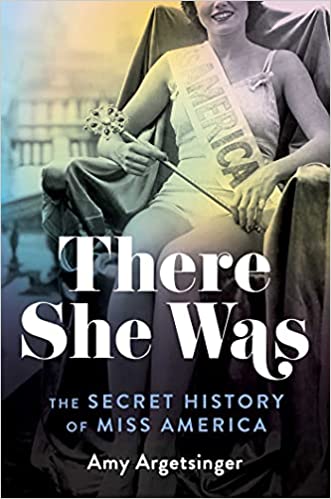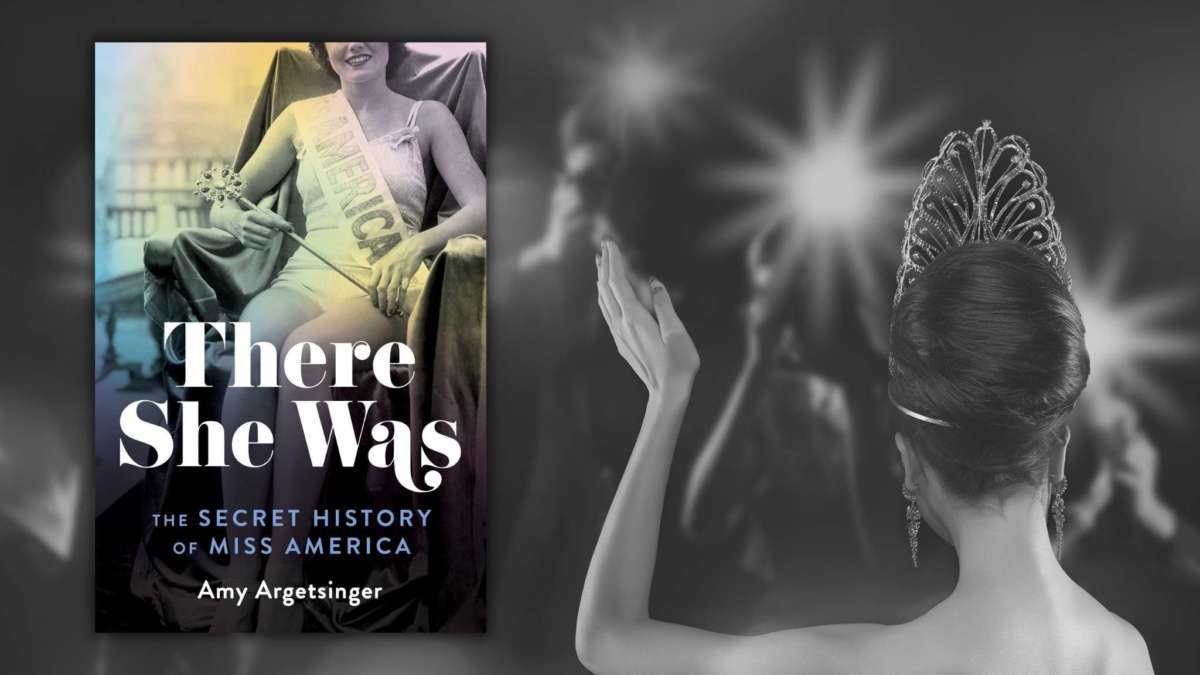There She Was: The Secret History of Miss America by Amy Argetsinger
Amid the centennial of the Miss America pageant, here comes a detailed history of the competition that arrived one year after American women were granted the right to vote. That seems like an appropriate coincidence, since the pageant is all about votes, right? Not so fast, argues author Amy Argetsinger, a Washington Post editor who has been fascinated by the event for well over a decade.
Intensively researched and engagingly written, There She Was: The Secret History of Miss America (Atria/One Signal Publishers) focuses largely on the personalities who shaped the pageant and those who were shaped by it. The cast of characters ranges from the original Atlantic City boosters, civic-minded men who saw the economic potential of the competition, to 1971 winner Phyllis George, who helped launch the “career girl” image, to 1988 winner television journalist Gretchen Carlson, who stepped up to rescue the pageant but ultimately was run out of town.
EXAMINING A CENTURY’S WORTH OF CHANGE
There She Was moves back and forth in time, juxtaposing a century’s worth of changes in social norms with the symbolism so deeply embedded in “Miss America.” The pageant began modestly, as a beauty contest in the early twenties at the dawn of Prohibition. Before long, it developed an unsavory aura, beset by rumors about vote-rigging and unwholesome girls. In 1935, the organizers remade its image by hiring Lenora Slaughter, a Southern Baptist lady who promised to beat back the hangers-on and make peace with church leaders. Somehow she imposed conservative values on an enterprise that showcased the female body.
As 1982 winner Elizabeth Gracen confessed to the author, “No one really told me that Miss America is a persona. I actually believed I had to be perfect.” Perfect body measurements, perfect hair and teeth, perfect personality, white, single, implicitly virginal — Lenora Slaughter’s rules endured. In the 1960s, Miss America met her match with the rise of the women’s movement and resistance to the objectification of women. No one could dispute that the pageant had sexist, racist undercurrents. Over time, its president and directors tried to respond to criticism, and sometimes they ignored it. Miss America alternately followed trends and led the way, Argetsinger suggests, but her point is that even a contestant who played against type felt haunted by the persona.
The book contains plenty of engrossing stories. There is the pageant’s shaming of 1984 winner Vanessa Williams and how the directors redeemed themselves by reinstating her in the pantheon. There is the directors’ attempt to banish the “Stepford aesthetic” by instituting, in 1989, a requirement that contestants adopt a social advocacy platform. (AIDS education and improving healthcare for veterans became popular issues.) Equally intriguing is the author’s exploration of how regional competitions feed into the national contest. The experiences of the women vying for the most modest of local titles turn out to be every bit as exhilarating, and discouraging, as those of the women who win state and advance to Miss America.
CARVING OUT A UNIQUE PERSONA VS. COACHING “TYPE”
The Miss Virginia competition — particularly the trajectory of musician and MFA candidate Caroline Weinroth, a multi-year contestant — receives considerable scrutiny in There She Was. Daughter of a Taiwanese-American mother and a Jewish father, Caroline is first glimpsed performing The Beatles’ “Come Together,” strumming an electric guitar and dressed in an evening gown that features black hot pants and streamers. After winning “Miss Apple Blossom,” Caroline takes several runs at the state competition.
“It’s like a performance of femininity,” she confides, “and beauty is a skill.” Caroline lost “Miss Northern Virginia” and “Miss Greater Prince William County,” finally winning “Miss Mountain Laurel” and subsequently “Miss Roanoke Valley.” It was a long slog, but, writes Argetsinger, “if she complained about this world, she loved it, too.” In June 2019, Caroline struck out of the Miss Virginia contest and went on with her life as leader of an indie-rock band.
Caroline Weinroth was an exception in carving out her own persona. Most young women who start in regional contests are coached into type. As the twenty-first century progressed, tension rose between coaches rooted in the postwar era and contestants who were born after 1980. The national organization tended to side with the contestants, pressuring local organizations to keep up with the current aesthetic, whether Disney princesses, hard bodies honed at the gym, or less hairspray. When Miss America eliminated the swimsuit competition in 2018, coaches and a surprisingly large number of contestants protested.
ILLUMINATING PAGEANT HISTORY … AND ITS FUTURE?
Although Miss America appears reliably year after year (except in 2020, due to Covid), readers may be surprised to learn that the competition has always operated somewhat precariously. Until 1954, when it was broadcast on television for the first time, Miss America’s directors worried about getting enough sponsors and paying the rent at Atlantic City’s Convention Hall. Ratings have dropped steadily since 1961, which drew about 69 million viewers; 2019 drew 3.6 million. Finances are always cause for concern.
Further, there has been frequent turnover in leadership, most recently in 2018 when several former winners staged a coup and Gretchen Carlson was anointed director before being overthrown herself. One can understand why there is so much conflict within the organization; it’s a matter of staying alive. Is it possible to keep the pageant compelling, projecting the right image for its time, when popular culture turns on a dime? Americans’ view of entertainment — what’s funny, what’s gripping, what’s authentic — evolves relentlessly. And what constitutes an exciting competition: Miss America or reality TV? One need not be a fan to wonder whether the pageant will remain relevant to American life.
In trying to divine the future, it is always helpful to turn to the past. Amy Argetsinger’s There She Was wonderfully illuminates the pageant’s history, showing how Miss America has adapted to change and where it has lagged. A half-century of “existential struggle,” as the author writes, has taken its toll, yet the contest continues to bring joy to millions of participants and observers.
The Miss America Pageant finals will air tonight at 8:00 ET on Peacock.





